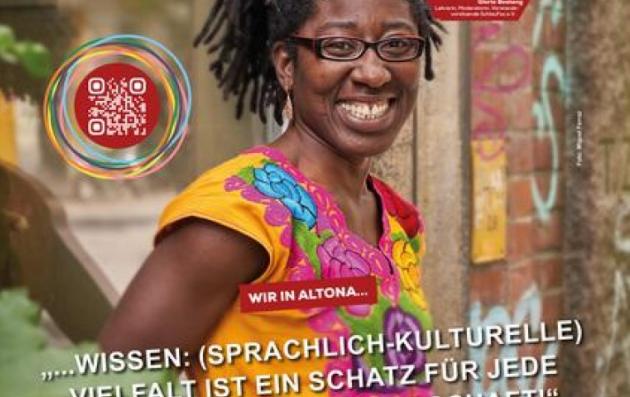Solutions offered by the good practice
Hamburg consists of seven districts and the district of Hamburg-Altona is the westernmost urban borough of Hamburg with a population of 270, 263 (Dec. 2016) with an area of 77.4 km2. The District of Altona is therefore part of the greater City of Hamburg, a major trading crossroads on the North- as well as Baltic Sea with both a long history of immigration and a growing, diverse population. Around 14% of the city’s residents are from first or second generation immigrant backgrounds, a statistic of foreign population growing in the district of Altona.
Between 2015-16, 60,000 refugees arrived in the city requiring the provision of extra accommodation and services and Hamburg employed some innovative processes to do this such the “Work and Integration Centre for Refugees – WIR-Centre” the Finding Places scheme- URBACT recognised Good Practice. A large proportion of refugees have been accommodated in Hamburg-Altona.
However, in recent years, the city has witnessed a disturbing rise in xenophobic populism and hate speech in both traditional and social media. Preoccupied for the phenomena, and for the attack of public opinion towards a pro-refugees agenda of the city of Hambourg, the District of Altona in 2018 analysed the situation in paper on integration and social inclusion. This paper led to a revision and updating of the local strategy from integration of minority groups (Integrationskonzept), towards comprehensive policies of inclusion and diversity targeting the whole population. While politicians were generally committed to this approach, they soon perceived the limits of issuing a top-down agenda in favour of tolerance and diversity., which would have been perceived by locals as imposed.
The solution evolved by joining the URBACT Transfer Network of Rumorless cities towards co-designing with inhabitants a formal declaration of inclusion and a campaign in public space about the principles exposed in the declaration. At first, public events and workshops have been organised across the district and via digital communications, inviting residents from different backgrounds to share their opinions on concepts such as social cohesion, community, democracy and equality and what sort of society they want to live in.
In the second phase, the content collected during phase one was collated and edited into seventeen statements. These were promoted at summer festivals across the district and people were encouraged to vote, to which 1 000 people responded. Subsequently, the declaration was launched at a press conference by the city mayor and by Marcell Jansen a famous local sportsperson. This was closely followed by a public democracy conference with the goal of supporting citizens to make the declaration their own and to develop ideas for spreading it’s messages and values. The declaration turned then into a campaign with printed and digital media in public spaces. Unfortunately, Covid-19 was tough for a campaign so strongly reliant on face-to-face activities. The work with schools was stopped, and Altona’s biggest cultural festival — potentially a powerful catalyst for promotion — was cancelled. This forced a creative rethink and a shift towards digital communications, including a campaign kit for civil society organisations.
Thankfully, the Mayor of Altona was personally committed, speaking at the launch event and referring back to the declaration in a public statement condemning discrimination after hate mail was sent to the Altona mosque.
Sustainable and integrated urban approach
Altona practice focuses on integrating the good practice of Rumourless cities across departments in the district offices and involving local population in co-designing the antidiscrimination campaigns that involves not only minority groups but the whole population. Altona is committed to exploring further ways to communicate and embed the declaration in the life and institutions of this district of Hamburg. For example, politicians have agreed to display a plaque of the declaration prominently on the town hall. A crucial target group is now schools and young people who will be invited to visit and discuss the values and ideas set out in the declaration.
Participatory approach
In Altona, a group of stakeholders was already co-developing an anti-discrimination strategy, including a set of principles to be known as the ‘Altona Declaration’. Joining URBACT RUMOURLESS CITIES Network was a chance to add inspiration and momentum to this campaign, and transform the initial idea of a top down anti-discrimination campaigning into a co-designed strategy (see Solution section). The existing stakeholder group in Altona formed an expanded URBACT Local Group (ULG), bringing political leaders and residents.
What difference has it made
The collaboration among inhabitants and city offices to co-create the Altona Declaration resulted in a series of 17 anti- discrimination statements posted online and promoted at events. 1000 people voted, selecting the top seven statements that formed the body of the declaration now part of a larger campaign involving public spaces in the district. The local partners and especially the ULG-members used the new kit, eg the flyers and posters, to disseminate the seven thesis of the Altona Declaration.
The change of attitudes is not easy to measure, especially not with the resources of the project. But one can be hopeful that some, more doubtful persons, started to reflect their personal points of view on diversity.
”In concrete terms, we were able to benefit from the exchange with the international partner cities. We learned how great the influence of positive rather than negative framing can be in conveying messages”. Adelina Michalk Department of Social Services, Municipality of Hamburg-Altona.
Transferring the practice
Hamburg/Altona found the regular peer review opportunities during transnational meetings of the Transfer network Rumorless cities particularly useful for taking on board practical tips and ideas for anti-rumour strategies. This included a ‘Gallery Walk’, where partner cities used visual images to capture their progress and exchange learning.
One notably valuable technique transferred from the city of Amadora, lead partner of the Transfer network, was the active involvement of ‘ambassadors’ to convey key messages to sections within the community. These elected officials, civil servants, and influential citizens assumed a pivotal role as the local campaign was rolled out.

